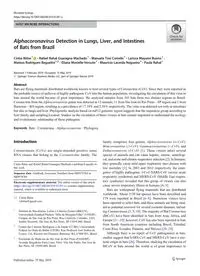
2019 Alphacoronavirus Detection in Lungs, Liver, and Intestines of Bats from Brazil PDF
Preview 2019 Alphacoronavirus Detection in Lungs, Liver, and Intestines of Bats from Brazil
HOST MICROBE INTERACTIONS Alphacoronavirus Detection in Lungs, Liver, and Intestines of Bats from Brazil Cíntia Bittar1 & Rafael Rahal Guaragna Machado1 & Manuela Tosi Comelis1 & Larissa Mayumi Bueno1 & Mateus Rodrigues Beguelini1,2 & Eliana Morielle-Versute1 & Maurício Lacerda Nogueira3 & Paula Rahal1 Received: 7 February 2019 /Accepted: 15 May 2019 # Springer Science+Business Media, LLC, part of Springer Nature 2019 Abstract Bats are flying mammals distributed worldwide known to host several types of Coronavirus (CoV). Since they were reported as the probable source of spillover of highly pathogenic CoVinto the human population, investigating the circulation of this virus in bats around the world became of great importance. We analyzed samples from 103 bats from two distinct regions in Brazil. Coronavirus from the Alphacoronavirus genus was detected in 12 animals, 11 from São José do Rio Preto—SP region and 1 from Barreiras—BA region, resulting in a prevalence of 17.18% and 2.56% respectively. The virus was detected not only in intestines but also in lungs and liver. Phylogenetic analysis based on nsP12 genomic region suggests that the sequences group according to host family and sampling location. Studies on the circulation of these viruses in bats remain important to understand the ecology and evolutionary relationship of these pathogens. Keywords Bats . Coronavirus . Alphacoronavirus . Phylogeny Introduction Coronaviruses (CoVs) are single-stranded positive sense RNA viruses that belong to the Coronaviridae family. The family comprises four genera: Alphacoronavirus (α-CoV), Betacoronavirus (β-CoV), Gammacoronavirus (γ-CoV), and Deltacoronavirus (δ-CoV) [1]. These viruses infect several species of animals and can cause hepatic, enteric, neurologi- cal, and acute and chronic respiratory infection [2]. In humans, they generally cause mild upper respiratory tract disease with low mortality [3]. In 2003 and 2012 respectively, the emer- gence of highly pathogenic β-CoV SARS-CoV (severe acute respiratory syndrome) and MERS-CoV (Middle East respira- tory syndrome) revealed that this group of viruses can also cause severe respiratory illness in humans [4, 5]. Bats are widespread flying mammals that are distributed worldwide. About 1150 bat species have been described and 179 were reported in Brazil [6–8]. Numerous viruses have been reported to infect bats, and these animals are being stud- ied as potential reservoir for several zoonotic diseases, includ- ing Coronaviruses [3, 9, 10]. The majority of Bat Coronavirus (BtCoV) have been identified in bats from Asia, Africa, and Europe [11–19]; however, CoV has also been reported in bats from South American countries including Brazil, Trinidad, Costa Rica, Ecuador, Panama, and Mexico [20–25]. Although there is no report of CoV pathogenesis in bats, studies suggest that SARS-CoVand MERS-CoV have a zoo- notic origin in bats [26]. Therefore, studying the circulation of BtCoV in bats around the world is of great importance to Cíntia Bittar and Rafael Rahal Guaragna Machado contributed equally to this work. Sequence data GenBank Accession Numbers from MH974764 to MH974780 Electronic supplementary material The online version of this article (https://doi.org/10.1007/s00248-019-01391-x) contains supplementary material, which is available to authorized users. * Cíntia Bittar
